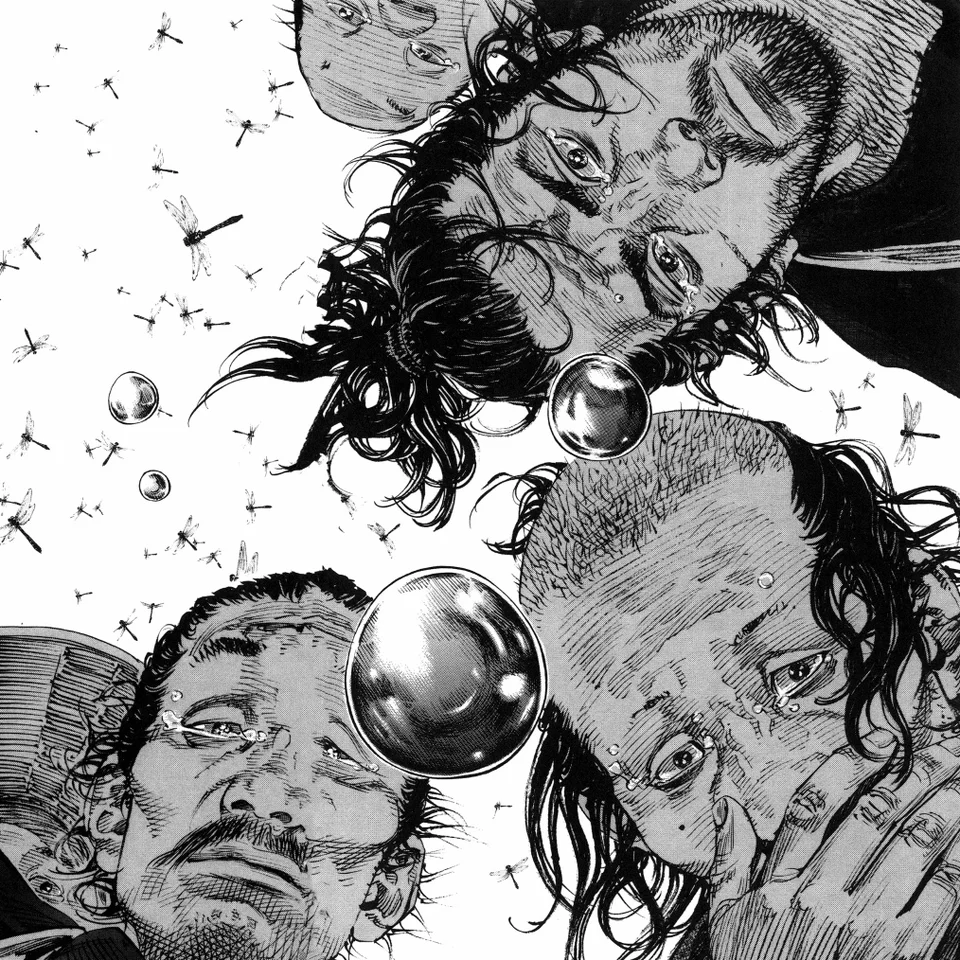Why Manga is Worth Your Time
2022-02-11
Manga is an art of the people, and Japanese people from all walks of life read and enjoy it. Though broadly similar to Western comics, manga draws from its own lineage of traditional Japanese art and deserves treatment on its own terms. Even Hokusai, more famous internationally for his woodblock prints of Mount Fuji, tried his hand at an early form of it.
But through a quirk of history, manga is still seen as a low-class art in the West. Popular manga often serve as source material for anime (Japanese animation), which still tends to be associated with children and the socially maladjusted. And it was through anime as a cultural export that manga became popular among Western audiences in the first place.
Though nerd culture is ascendant in a way I couldn't have imagined two decades ago, animation itself is often maligned in the broader culture as an unserious art. How much more so, then, for manga?
 Panel from Takehiko Inoue's Vagabond
Panel from Takehiko Inoue's Vagabond
This is a shame, because I think manga gives us things few artforms can.
First, rich symbolic storytelling.
Live action is wonderful, but its major weakness is that there are scenes it simply can't depict without breaking the audience's immersion. The modern ubiquity of special effects has removed some of these restrictions, but the story is ultimately still constrained by the rules of the real world.
Drawings, however, are symbolic and can be extensively manipulated in the hands of a master. By working symbolically, visual artists can communicate at a speed and scale that would be impossible in a life-action format, and they can make even deeper changes without breaking the flow of the story.
This is part of what makes graphic novels like Maus, which depicts its characters as various animals, so compelling and so untranslatable to other media. As a graphic novel, it is a poignant meditation on the Holocaust. A faithful live-action adaptation would be a laughingstock.
Second, a single authorial vision.
Film is a collaborative medium, and even the smallest indie films need to work with the creative preferences of the actors. At its best, this can make a film especially rich and dense. But the downside of this mix of voices is that we sometimes lose track of the unified vision of a single auteur.
A capable manga author, meanwhile, is director, actor, writer, and cinematographer all in one. Though they might have an editor or a team of assistants, what an author creates is fundamentally their own, for better or for worse.
Third, a large community of passionate professionals.
The mainstream appeal of manga in Japan means that the manga scene there is healthy and full of talented professionals. As an extension of Japanese work culture, manga authors work incredibly long hours that are, frankly, unhealthy. But the result of that work is that they produce huge volumes of high-quality output on nearly every subject imaginable.
As a joke for this post, I thought I would search for manga about the sport of curling, and I found five. Five manga about curling alone. If there's an activity that's somewhat well-known, there's probably a manga about it.
Manga I like
Like any medium, manga has stories that I find lurid or cringeworthy. But everyone has their own tastes, and what's important is that there's plenty I find profound and inspiring.
Here are some of my favorites:
-
Vagabond — The life of Miyamoto Musashi, the greatest swordsman of the Tokugawa era. Life, growth, mastery, love, enlightenment, excellent fights, and what it means to be a human being. Magnificent and profound. Exceptional art. (See above for a small example.) The series is on indefinite hiatus, but the historical record makes the ending clear, and the series has already come to a natural and satisfying stopping point.
-
Yugami Doesn't Have Any Friends — A lighthearted but surprisingly deep look at the life of a boy who's happy alone and the people in his class at school. Funny and charming with a good message about being yourself and learning to open up to others.
-
Goodnight Punpun — The story of a scared little boy named Punpun and his painful adolescence. Love, tragedy, nihilism and meaning, and childhood idealism. Trigger warnings for everything, including physical and sexual abuse. Exceptional art.
-
Lone Wolf and Cub — A samurai and his son take revenge against the Yagyu clan. In a word it's about bushi, the warrior spirit of the samurai. It's mainly episodic with occasional digressions into the life and times of the Tokugawa era, but it does have a larger story and a masterful ending. Exceptional art almost in the style of ink wash paintings.
-
Uzumaki — Existential horror. The author is a master of his craft, so I enjoyed it despite the genre. Exceptional(ly terrifying) art.
Two final notes:
-
Most manga is read right-to-left.
-
You should buy official translations where you can, but many translations are in a gray area, and you can often find a series by searching for
<title> chapter 1on Google.